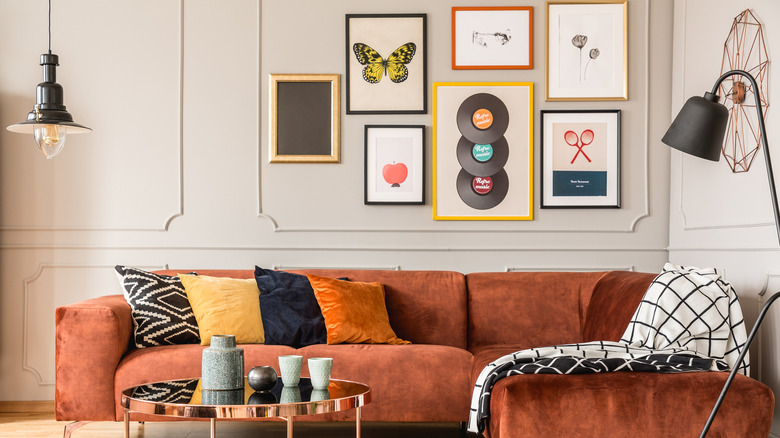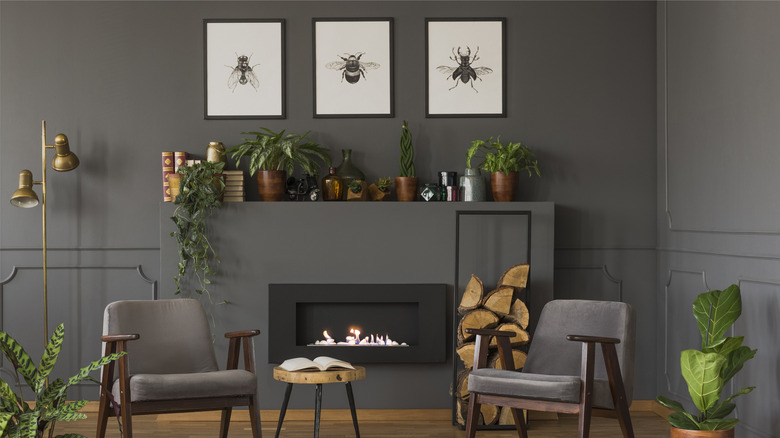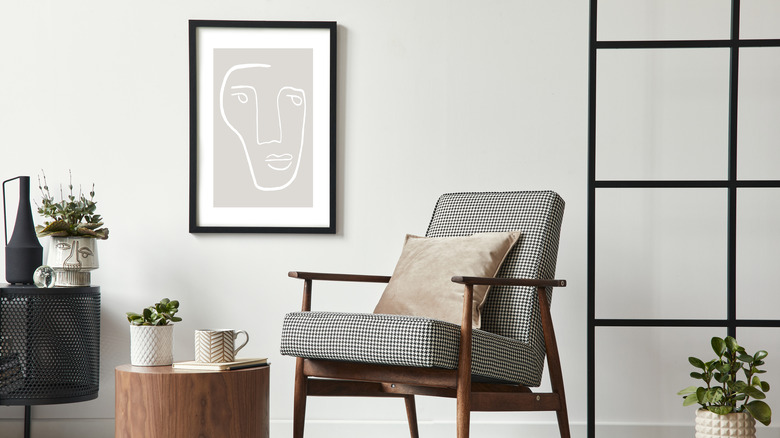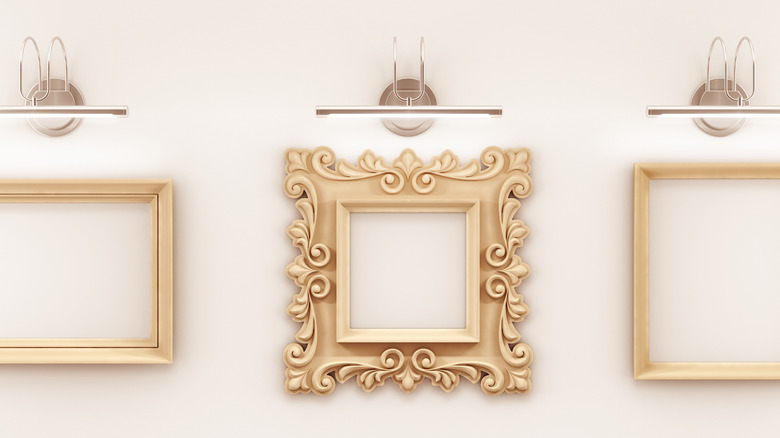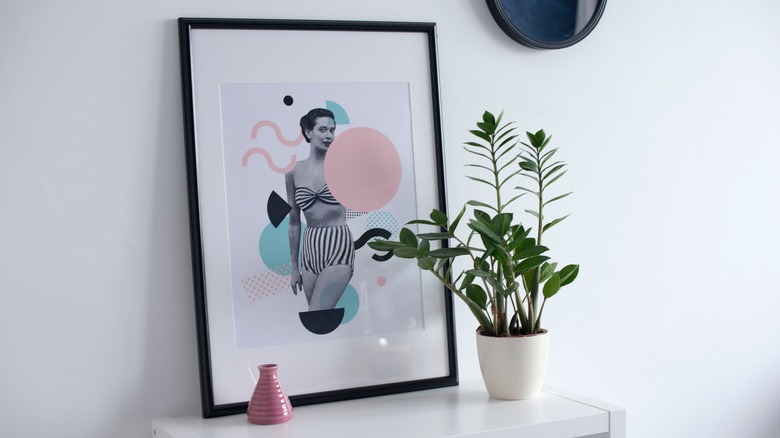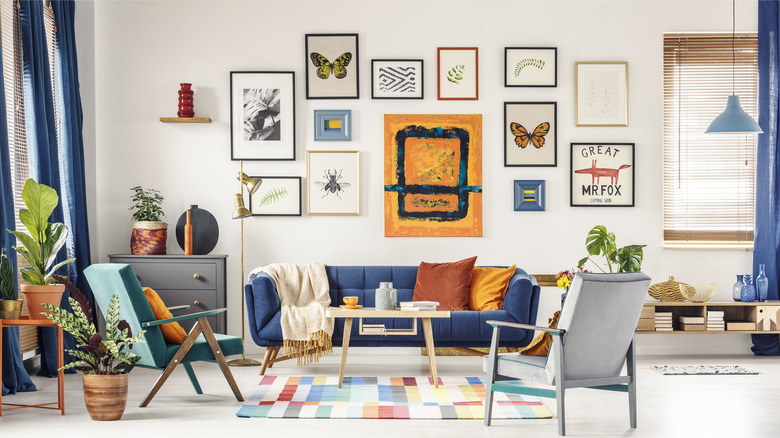How To Make Art The Focal Point In A Room
Decorating your home is an incredibly personal process, as well as a great opportunity to express yourself. While staple furniture pieces are a major factor when it comes to setting the tone of a room, the surrounding décor is just as important for making your space a true reflection of yourself.
One fantastic way to reflect your tastes through decorating is with art. Whether you made it yourself, purchased it from a local gallery or artist, or want to display your favorite posters, having art in your home is always a good idea. According to Paintings In Hospitals, studies have shown that being surrounded by art leads to higher levels of dopamine, as well as a general increased sense of happiness, satisfaction, and well-being. Deciding how to display your art, though, can be an overwhelming process. It can easily get lost in the background of a room. Keep reading for ideas on how to make art the focal point of your decor.
1. Opt for dark walls
One easy way to make art stand out in your home is by giving it a background to truly stand out against. As Mastercraft Painting & Finishes points out, dark walls will offer lots of contrast against your art, helping highlight the frames and make the artwork stand out. Dark walls are also very sleek and timeless, and if you have enough art, you can create a museum-like effect with a dark matte paint.
A fun way to incorporate dark paint with your artwork is to match the wall color to one of the main hues in the painting itself. For example, if your art piece or pieces feature lots of blues, consider painting your wall a very dark blue. A sleek black or dark gray will also offer lots of versatility and flexibility later down the road. As a plus, dark walls are a lot easier to keep clean, which will keep your artwork looking as gorgeous as possible.
2. Choose the right frames
Another way to draw attention to the art in your home is to choose appropriately sized and proportioned frames. Framing your art prints, photographs, or posters incorrectly can make it look awkward and even attract negative attention.
While most people assume they should just choose a frame the same dimensions of their art, Displays 2 Go advises against that. On the flip side, though, you shouldn't go too much larger than the original art dimensions. In general, they recommend a frame that is an inch larger than the print in terms of length and width. If the frame is too small, your artwork will look cramped and awkward. If it's too large, the frame will engulf the art, and it also risks slipping. You should also look for frames that include backboards, especially for things like posters and photographs, so that they can stand out and you don't have to try and figure out how to calculate the margins.
3. Add lighting
Museums and art galleries display tons of artwork, and a lot can be learned from their tips and tricks. One great idea you can borrow from art galleries to draw attention to the art in your home is to include art lights. Not only will this make the art the central focus of your room, but it will also give your home a sophisticated look.
A lot goes into lighting artwork than simply adding track lights, though, per Erin Hanson. For example, you need to decide if you want ceiling or wall mounted art lights. Ceiling lights are definitely great, but they assume the art will be a permanent fixture. Ceiling mounted art lights are usually track lights, whether hanging or recessed. This is because you want the light to hit the art at a 30 to 45 degree angle.
Wall mounted lights are a little less complicated and have the option of being temporary, but they can be a little bit harsher. Look for specific art lights, which are small strips that hang above frames and cast light directly downward. They can be powered usually through batteries or an outlet. Regardless of which option you choose, the final result will be stunning and sure to attract attention to your art.
4. Make use of shelves
Hanging art on your walls is definitely a great way to make it the focal point of a room. However, it isn't the only way. If you have multiple pieces you want to display, smaller art, lots of clutter and knick-knack items, or simply just don't want to hang your art, consider displaying it on a dedicated art shelf.
As Love Grows Wild notes, having one large shelf only adds a few holes to your wall but endless customization opportunities, as opposed to hanging multiple pieces of art and changing your mind later, which leaves behind lots of holes in your wall. There are plenty of shelves on the market, but making your own is also quite easy. What you should look for is a shelf with a deep enough ledge that you can put frames and other decorative items on it, but it should also have a front lip that prevents those items from slipping off.
5. Create a gallery wall
Finally, one of the most trendy and customizable ways to make art a true focal point in your home is to create a gorgeous and eclectic gallery wall. A gallery wall is just what it sounds like — a collection of framed artwork arranged on a large wall. There is quite a bit of prep work that should go into creating a gallery wall, though. Simply tacking up multiple pieces of art may work out well, but it leaves little room for you to change your mind.
This is why you should take some time to plan out your gallery wall in advance. To begin, Emily Henderson recommends choosing your art pieces ahead of time, making sure the colors all go well together. The issue with gallery walls is their tendency to be overwhelming and cluttered, so keeping them cohesive can help avoid this problem. Next, make sure you have multiple sizes and orientations of artwork. To plan out your gallery wall, cut out similarly proportioned pieces of paper and lay them out on the ground to create a mock grid, which can help you arrange the pieces without putting holes in the wall. Start with your largest pieces and use the smaller ones to fill in the gaps.
